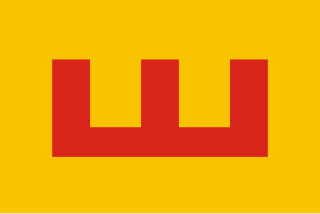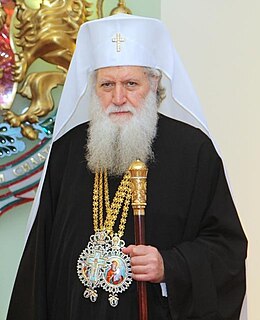This page is based on this
Wikipedia article Text is available under the
CC BY-SA 4.0 license; additional terms may apply.
Images, videos and audio are available under their respective licenses.

The Battle of Kleidion took place on July 29, 1014 between the Byzantine Empire and the Bulgarian Empire. It was the culmination of the nearly half-century struggle between the Byzantine Emperor Basil II and the Bulgarian Emperor Samuil in the late 10th and early 11th centuries. The result was a decisive Byzantine victory.

Simeon I the Great ruled over Bulgaria from 893 to 927, during the First Bulgarian Empire. Simeon's successful campaigns against the Byzantines, Magyars and Serbs led Bulgaria to its greatest territorial expansion ever, making it the most powerful state in contemporary Eastern Europe. His reign was also a period of unmatched cultural prosperity and enlightenment later deemed the Golden Age of Bulgarian culture.

The Archbishopric of Ohrid, also known as the Bulgarian Archbishopric of Ohrid, originally called Archbishopric of Justiniana Prima and all Bulgaria, was an autonomous Orthodox Church under the tutelage of the Ecumenical Patriarch of Constantinople between 1019 and 1767. It was established following the Byzantine conquest of the First Bulgarian Empire in 1018 by lowering the rank of the autocephalous Bulgarian Patriarchate due to its subjugation to Constantinople.

The Second Bulgarian Empire was a medieval Bulgarian state that existed between 1185 and 1396. A successor to the First Bulgarian Empire, it reached the peak of its power under Tsars Kaloyan and Ivan Asen II before gradually being conquered by the Ottomans in the late 14th and early 15th centuries. It was succeeded by the Principality and later Kingdom of Bulgaria in 1878.

In the medieval history of Europe, Bulgaria's status as the Bulgarian Empire, wherein it acted as a key regional power occurred in two distinct periods: between the seventh and eleventh centuries, and again between the twelfth and fourteenth centuries. The two "Bulgarian Empires" are not treated as separate entities, but rather as one state restored after a period of Byzantine rule over its territory. Bulgaria is one of the few historic states and nations whose economy and society were never based on slavery, and slavery never played an important role in Bulgarian statehood development and wealth.
The Battle of Pegae was fought between 11 and 18 March 921 in the outskirts of Constantinople between the forces of the Bulgarian Empire and the Byzantine Empire during the Byzantine–Bulgarian war of 913–927. The battle took place in a locality called Pegae, named after the nearby Church of St. Mary of the Spring. The Byzantine lines collapsed at the very first Bulgarian attack and their commanders fled the battlefield. In the subsequent rout most Byzantine soldiers were killed by the sword, drowned or were captured.
The Archbishop of Ohrid is a historic title given to the primate of the Archbishopric of Ohrid.

Rūm millet, or "Roman nation", was the name of the Eastern Orthodox Christian community in the Ottoman Empire. In fact, the Christians were conquered by Islam, but enjoyed a certain internal autonomy.
The Byzantine–Bulgarian war of 894–896, also called the Trade war, was fought between the Bulgarian Empire and the Byzantine Empire as a result of the decision of the Byzantine emperor Leo VI to move the Bulgarian market from Constantinople to Thessaloniki which would greatly increase the expenses of the Bulgarian merchants.
The Byzantine–Bulgarian war of 913–927 was fought between the Bulgarian Empire and the Byzantine Empire for more than a decade. Although the war was provoked by the Byzantine emperor Alexander's decision to discontinue paying an annual tribute to Bulgaria, the military and ideological initiative was held by Simeon I of Bulgaria, who demanded to be recognized as Tsar and made it clear that he aimed to conquer not only Constantinople but the rest of the Byzantine Empire, as well.
The Battle of Constantinople was fought in June 922 at the outskirts of the capital of the Byzantine Empire, Constantinople, between the forces of the First Bulgarian Empire and the Byzantines during the Byzantine–Bulgarian war of 913–927. In the summer the Byzantine Emperor Romanos I Lekapenos sent troops under the commander Saktikios to repel another Bulgarian raid at the outskirts of the Byzantine capital. The Byzantines stormed the Bulgarian camp but were defeated when they confronted the main Bulgarian forces. During his flight from the battlefield Saktikios was mortally wounded and died the following night.
Leontius was the first Patriarch of the Bulgarian Orthodox Church. Very little is known of his life and tenure. He was mentioned as the first Patriarch of Bulgaria in the Book of Boril, written in 1211.
Demetrius was the second Patriarch of the Bulgarian Orthodox Church and the first one to have been recognized by the Ecumenical Patriarch of Constantinople as a result of the Byzantine–Bulgarian Treaty of 927, which affirmed the Bulgarian victory in the War of 913–927 against the Byzantine Empire. Demetrius headed the Bulgarian Patriarchate in the first years of the reign of emperor Peter I.
Joachim III was the Patriarch of the Bulgarian Orthodox Church between c. 1282 and 1300, when the Second Bulgarian Empire reached its lowest point of decline during the reign of the emperors George Terter I, Smilets and Chaka. He was executed for treason by emperor Theodore Svetoslav in 1300. The Church did not recognize his guilt and his name was included in the list of Bulgarian Patriarchs in the Book of Boril. His seat was Tarnovo, the capital of Bulgaria.
Ignatius was a Patriarch of the Bulgarian Orthodox Church in the 13th century during the rule of Emperor Konstantin Tih. He is listed as the fourth Patriarch presiding over the Bulgarian Church from Tarnovo in the medieval Book of Boril.
Joachim I was the Patriarch of the Bulgarian Orthodox Church between 1235 and 1246. He was the first head of the restored Bulgarian Patriarchate with seat in Tarnovo, the capital of the Second Bulgarian Empire. Joachim I died of natural death on 18 January 1246 and was proclaimed a saint. He was the founder of an extensive monastic complex known as the Rock-hewn Churches of Ivanovo, now included in the UNESCO World Heritage List.

























